Operations Strategy: Definition, Formulation and Impact - SBAA7027
VerifiedAdded on 2022/01/23
|117
|28836
|27
Report
AI Summary
This report provides a comprehensive overview of operations strategy, starting with its fundamental definition and concept, and extending to its crucial importance and integration with corporate strategy. It delves into operations strategy formulation, specifically the Hill framework, and the strategic fit concept, essential for aligning operations with overall business goals. The report explores various strategies, values, and services within operations management, alongside strategic areas such as capacity, supply network, and process technology strategies. It differentiates between operations management and operations strategy, offering a holistic view of how operations can be a key driver of competitive advantage. The report also outlines the decision areas within operations strategy, providing a detailed understanding of the subject. This report is a valuable resource for students seeking to understand and apply operations strategy principles.
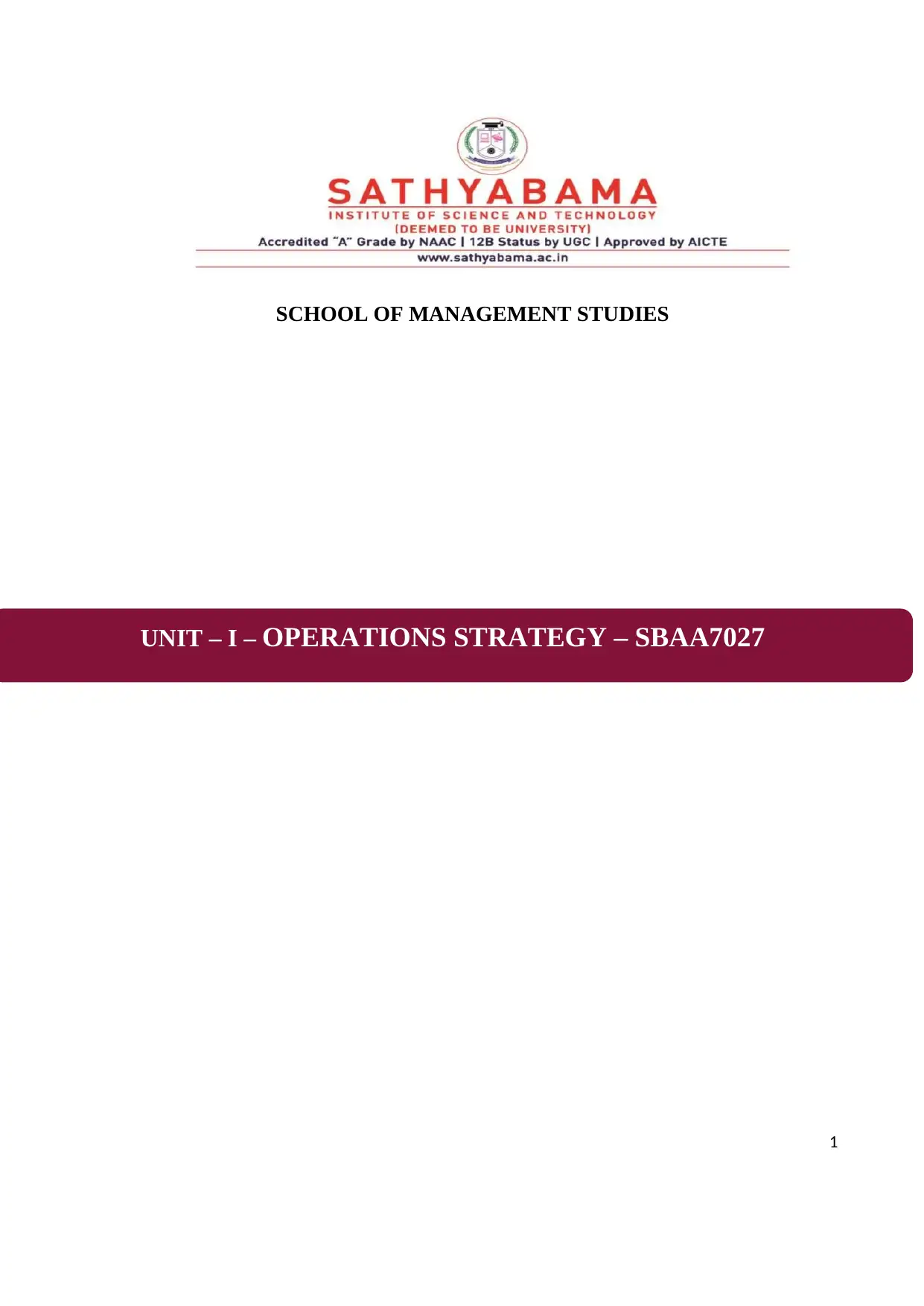
1
SCHOOL OF MANAGEMENT STUDIES
UNIT – I – OPERATIONS STRATEGY – SBAA7027
SCHOOL OF MANAGEMENT STUDIES
UNIT – I – OPERATIONS STRATEGY – SBAA7027
Paraphrase This Document
Need a fresh take? Get an instant paraphrase of this document with our AI Paraphraser
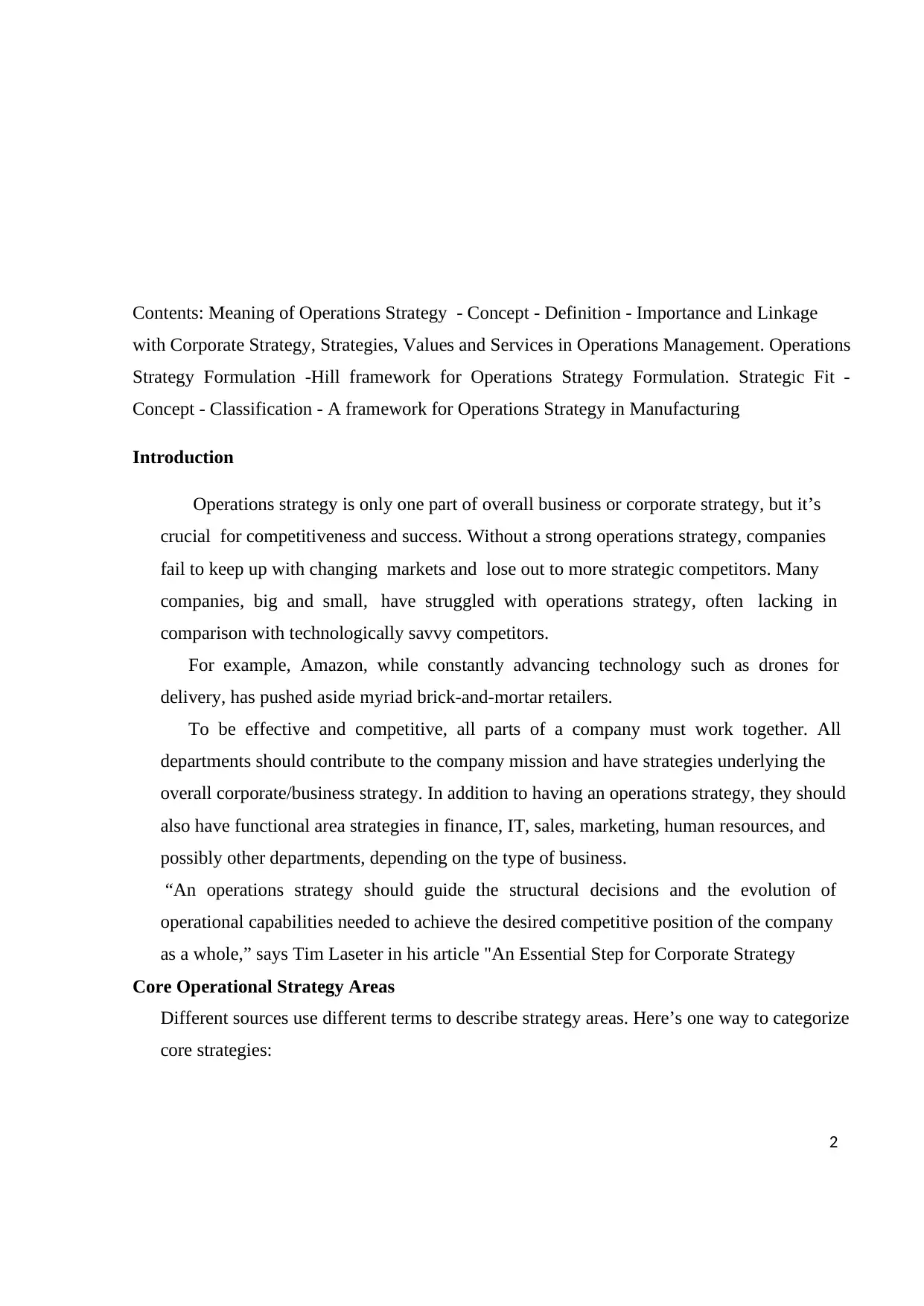
2
Contents: Meaning of Operations Strategy - Concept - Definition - Importance and Linkage
with Corporate Strategy, Strategies, Values and Services in Operations Management. Operations
Strategy Formulation -Hill framework for Operations Strategy Formulation. Strategic Fit -
Concept - Classification - A framework for Operations Strategy in Manufacturing
Introduction
Operations strategy is only one part of overall business or corporate strategy, but it’s
crucial for competitiveness and success. Without a strong operations strategy, companies
fail to keep up with changing markets and lose out to more strategic competitors. Many
companies, big and small, have struggled with operations strategy, often lacking in
comparison with technologically savvy competitors.
For example, Amazon, while constantly advancing technology such as drones for
delivery, has pushed aside myriad brick-and-mortar retailers.
To be effective and competitive, all parts of a company must work together. All
departments should contribute to the company mission and have strategies underlying the
overall corporate/business strategy. In addition to having an operations strategy, they should
also have functional area strategies in finance, IT, sales, marketing, human resources, and
possibly other departments, depending on the type of business.
“An operations strategy should guide the structural decisions and the evolution of
operational capabilities needed to achieve the desired competitive position of the company
as a whole,” says Tim Laseter in his article "An Essential Step for Corporate Strategy
Core Operational Strategy Areas
Different sources use different terms to describe strategy areas. Here’s one way to categorize
core strategies:
Contents: Meaning of Operations Strategy - Concept - Definition - Importance and Linkage
with Corporate Strategy, Strategies, Values and Services in Operations Management. Operations
Strategy Formulation -Hill framework for Operations Strategy Formulation. Strategic Fit -
Concept - Classification - A framework for Operations Strategy in Manufacturing
Introduction
Operations strategy is only one part of overall business or corporate strategy, but it’s
crucial for competitiveness and success. Without a strong operations strategy, companies
fail to keep up with changing markets and lose out to more strategic competitors. Many
companies, big and small, have struggled with operations strategy, often lacking in
comparison with technologically savvy competitors.
For example, Amazon, while constantly advancing technology such as drones for
delivery, has pushed aside myriad brick-and-mortar retailers.
To be effective and competitive, all parts of a company must work together. All
departments should contribute to the company mission and have strategies underlying the
overall corporate/business strategy. In addition to having an operations strategy, they should
also have functional area strategies in finance, IT, sales, marketing, human resources, and
possibly other departments, depending on the type of business.
“An operations strategy should guide the structural decisions and the evolution of
operational capabilities needed to achieve the desired competitive position of the company
as a whole,” says Tim Laseter in his article "An Essential Step for Corporate Strategy
Core Operational Strategy Areas
Different sources use different terms to describe strategy areas. Here’s one way to categorize
core strategies:
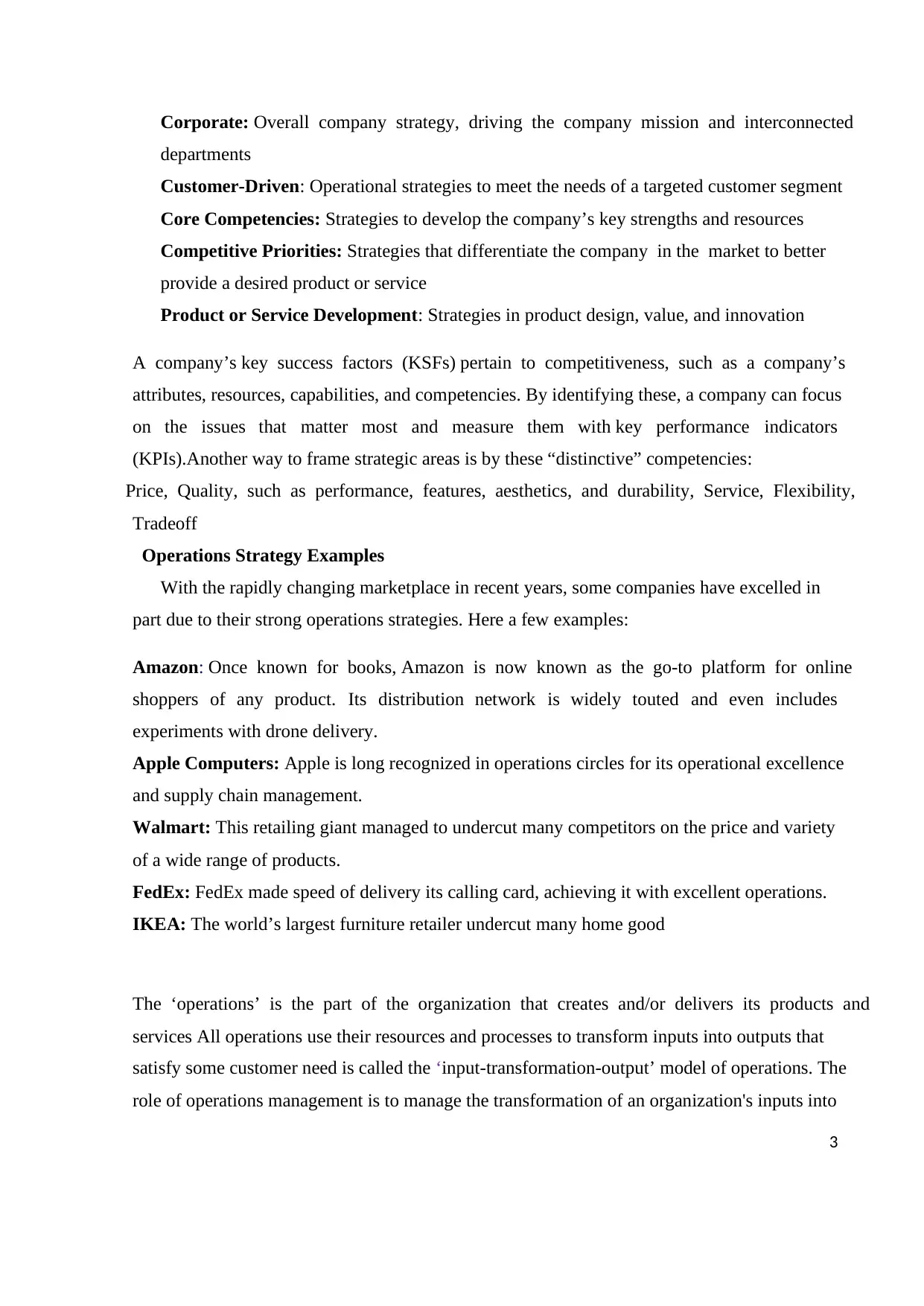
3
Corporate: Overall company strategy, driving the company mission and interconnected
departments
Customer-Driven: Operational strategies to meet the needs of a targeted customer segment
Core Competencies: Strategies to develop the company’s key strengths and resources
Competitive Priorities: Strategies that differentiate the company in the market to better
provide a desired product or service
Product or Service Development: Strategies in product design, value, and innovation
A company’s key success factors (KSFs) pertain to competitiveness, such as a company’s
attributes, resources, capabilities, and competencies. By identifying these, a company can focus
on the issues that matter most and measure them with key performance indicators
(KPIs).Another way to frame strategic areas is by these “distinctive” competencies:
Price, Quality, such as performance, features, aesthetics, and durability, Service, Flexibility,
Tradeoff
Operations Strategy Examples
With the rapidly changing marketplace in recent years, some companies have excelled in
part due to their strong operations strategies. Here a few examples:
Amazon: Once known for books, Amazon is now known as the go-to platform for online
shoppers of any product. Its distribution network is widely touted and even includes
experiments with drone delivery.
Apple Computers: Apple is long recognized in operations circles for its operational excellence
and supply chain management.
Walmart: This retailing giant managed to undercut many competitors on the price and variety
of a wide range of products.
FedEx: FedEx made speed of delivery its calling card, achieving it with excellent operations.
IKEA: The world’s largest furniture retailer undercut many home good
The ‘operations’ is the part of the organization that creates and/or delivers its products and
services All operations use their resources and processes to transform inputs into outputs that
satisfy some customer need is called the ‘input-transformation-output’ model of operations. The
role of operations management is to manage the transformation of an organization's inputs into
Corporate: Overall company strategy, driving the company mission and interconnected
departments
Customer-Driven: Operational strategies to meet the needs of a targeted customer segment
Core Competencies: Strategies to develop the company’s key strengths and resources
Competitive Priorities: Strategies that differentiate the company in the market to better
provide a desired product or service
Product or Service Development: Strategies in product design, value, and innovation
A company’s key success factors (KSFs) pertain to competitiveness, such as a company’s
attributes, resources, capabilities, and competencies. By identifying these, a company can focus
on the issues that matter most and measure them with key performance indicators
(KPIs).Another way to frame strategic areas is by these “distinctive” competencies:
Price, Quality, such as performance, features, aesthetics, and durability, Service, Flexibility,
Tradeoff
Operations Strategy Examples
With the rapidly changing marketplace in recent years, some companies have excelled in
part due to their strong operations strategies. Here a few examples:
Amazon: Once known for books, Amazon is now known as the go-to platform for online
shoppers of any product. Its distribution network is widely touted and even includes
experiments with drone delivery.
Apple Computers: Apple is long recognized in operations circles for its operational excellence
and supply chain management.
Walmart: This retailing giant managed to undercut many competitors on the price and variety
of a wide range of products.
FedEx: FedEx made speed of delivery its calling card, achieving it with excellent operations.
IKEA: The world’s largest furniture retailer undercut many home good
The ‘operations’ is the part of the organization that creates and/or delivers its products and
services All operations use their resources and processes to transform inputs into outputs that
satisfy some customer need is called the ‘input-transformation-output’ model of operations. The
role of operations management is to manage the transformation of an organization's inputs into
⊘ This is a preview!⊘
Do you want full access?
Subscribe today to unlock all pages.

Trusted by 1+ million students worldwide
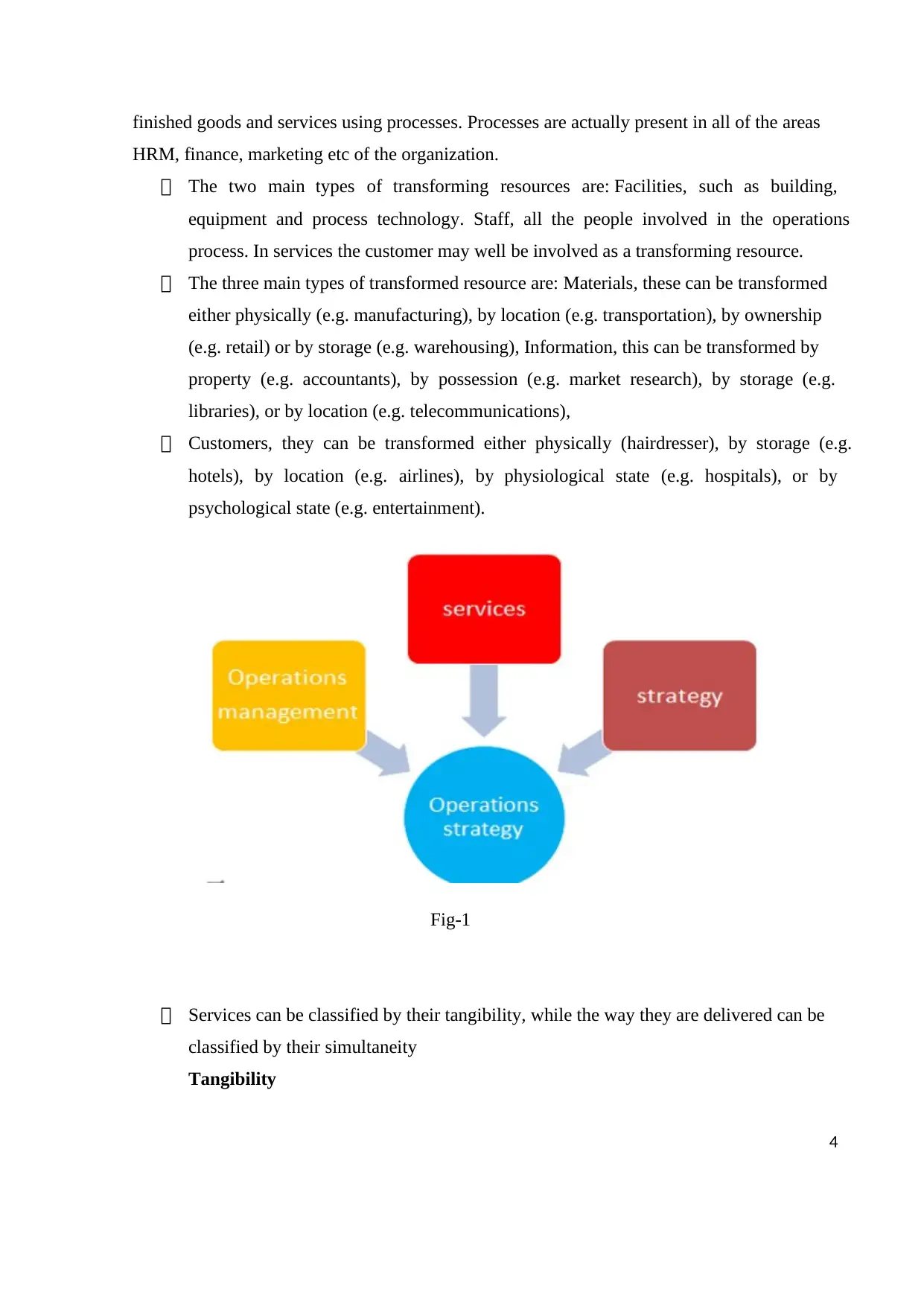
4
finished goods and services using processes. Processes are actually present in all of the areas
HRM, finance, marketing etc of the organization.
The two main types of transforming resources are: Facilities, such as building,
equipment and process technology. Staff, all the people involved in the operations
process. In services the customer may well be involved as a transforming resource.
The three main types of transformed resource are: Materials, these can be transformed
either physically (e.g. manufacturing), by location (e.g. transportation), by ownership
(e.g. retail) or by storage (e.g. warehousing), Information, this can be transformed by
property (e.g. accountants), by possession (e.g. market research), by storage (e.g.
libraries), or by location (e.g. telecommunications),
Customers, they can be transformed either physically (hairdresser), by storage (e.g.
hotels), by location (e.g. airlines), by physiological state (e.g. hospitals), or by
psychological state (e.g. entertainment).
Fig-1
Services can be classified by their tangibility, while the way they are delivered can be
classified by their simultaneity
Tangibility
finished goods and services using processes. Processes are actually present in all of the areas
HRM, finance, marketing etc of the organization.
The two main types of transforming resources are: Facilities, such as building,
equipment and process technology. Staff, all the people involved in the operations
process. In services the customer may well be involved as a transforming resource.
The three main types of transformed resource are: Materials, these can be transformed
either physically (e.g. manufacturing), by location (e.g. transportation), by ownership
(e.g. retail) or by storage (e.g. warehousing), Information, this can be transformed by
property (e.g. accountants), by possession (e.g. market research), by storage (e.g.
libraries), or by location (e.g. telecommunications),
Customers, they can be transformed either physically (hairdresser), by storage (e.g.
hotels), by location (e.g. airlines), by physiological state (e.g. hospitals), or by
psychological state (e.g. entertainment).
Fig-1
Services can be classified by their tangibility, while the way they are delivered can be
classified by their simultaneity
Tangibility
Paraphrase This Document
Need a fresh take? Get an instant paraphrase of this document with our AI Paraphraser
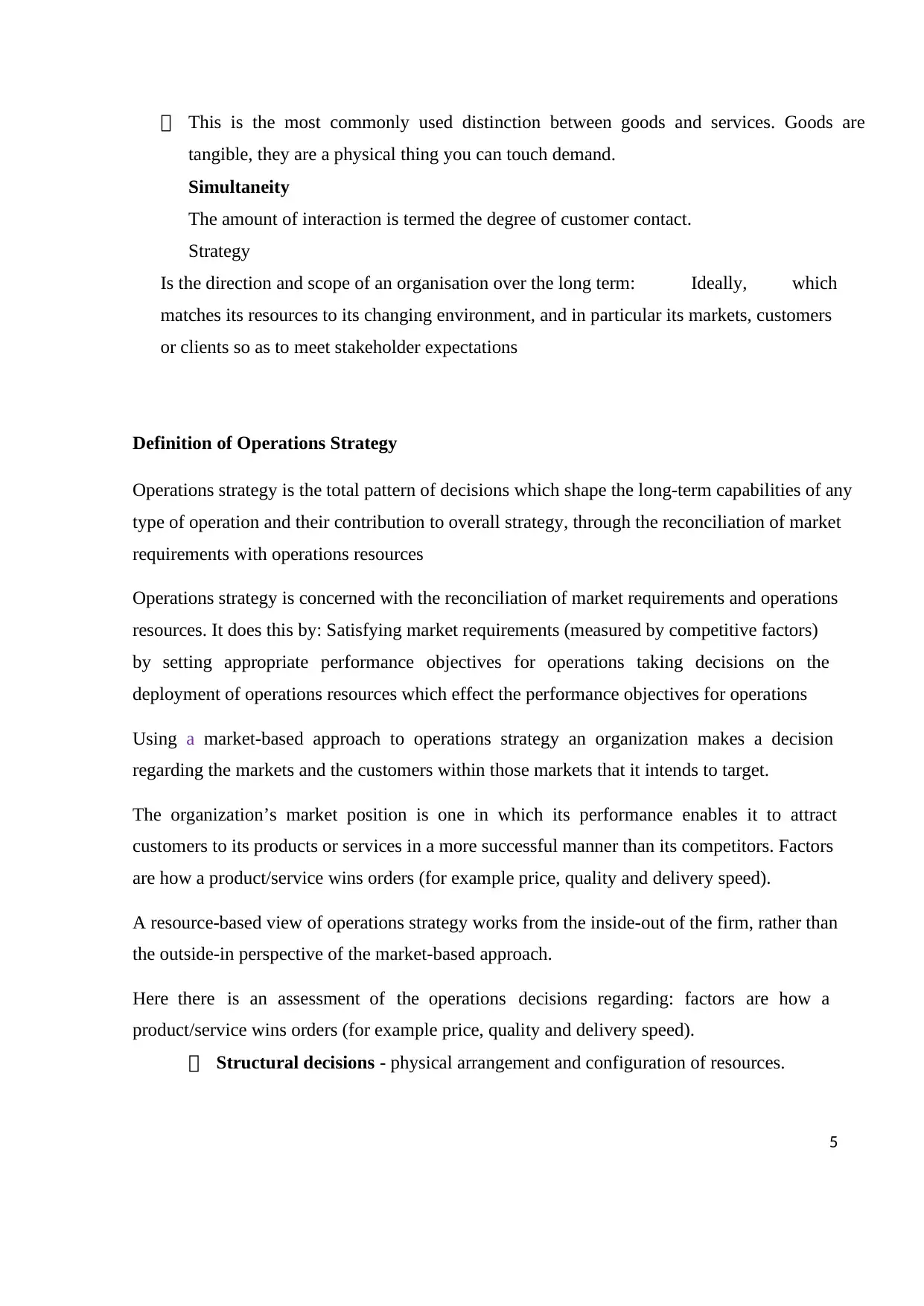
5
This is the most commonly used distinction between goods and services. Goods are
tangible, they are a physical thing you can touch demand.
Simultaneity
The amount of interaction is termed the degree of customer contact.
Strategy
Is the direction and scope of an organisation over the long term: Ideally, which
matches its resources to its changing environment, and in particular its markets, customers
or clients so as to meet stakeholder expectations
Definition of Operations Strategy
Operations strategy is the total pattern of decisions which shape the long-term capabilities of any
type of operation and their contribution to overall strategy, through the reconciliation of market
requirements with operations resources
Operations strategy is concerned with the reconciliation of market requirements and operations
resources. It does this by: Satisfying market requirements (measured by competitive factors)
by setting appropriate performance objectives for operations taking decisions on the
deployment of operations resources which effect the performance objectives for operations
Using a market-based approach to operations strategy an organization makes a decision
regarding the markets and the customers within those markets that it intends to target.
The organization’s market position is one in which its performance enables it to attract
customers to its products or services in a more successful manner than its competitors. Factors
are how a product/service wins orders (for example price, quality and delivery speed).
A resource-based view of operations strategy works from the inside-out of the firm, rather than
the outside-in perspective of the market-based approach.
Here there is an assessment of the operations decisions regarding: factors are how a
product/service wins orders (for example price, quality and delivery speed).
Structural decisions - physical arrangement and configuration of resources.
This is the most commonly used distinction between goods and services. Goods are
tangible, they are a physical thing you can touch demand.
Simultaneity
The amount of interaction is termed the degree of customer contact.
Strategy
Is the direction and scope of an organisation over the long term: Ideally, which
matches its resources to its changing environment, and in particular its markets, customers
or clients so as to meet stakeholder expectations
Definition of Operations Strategy
Operations strategy is the total pattern of decisions which shape the long-term capabilities of any
type of operation and their contribution to overall strategy, through the reconciliation of market
requirements with operations resources
Operations strategy is concerned with the reconciliation of market requirements and operations
resources. It does this by: Satisfying market requirements (measured by competitive factors)
by setting appropriate performance objectives for operations taking decisions on the
deployment of operations resources which effect the performance objectives for operations
Using a market-based approach to operations strategy an organization makes a decision
regarding the markets and the customers within those markets that it intends to target.
The organization’s market position is one in which its performance enables it to attract
customers to its products or services in a more successful manner than its competitors. Factors
are how a product/service wins orders (for example price, quality and delivery speed).
A resource-based view of operations strategy works from the inside-out of the firm, rather than
the outside-in perspective of the market-based approach.
Here there is an assessment of the operations decisions regarding: factors are how a
product/service wins orders (for example price, quality and delivery speed).
Structural decisions - physical arrangement and configuration of resources.

6
Infrastructural decisions - activities that take place within the operation’s
structure.
The nature and complexity of formal and informal processes and tangible and intangible
resources is central to the resource- based view of strategy; that is externally unobservable
(within firm) factors are at least as important as observable industry market (between firm)
factors in determining competitive advantage.
It has been found that not all companies pursue strategy in accordance with a pure
market-based approach and it has been found that competitiveness is not just a matter of
simply improving performance along specific competitive dimensions in response to market
needs, but incorporates the development of capabilities that provide specific operating
advantages.
Thus the resource-based view of strategy is that an operation takes a more active role in
providing long-term competitive advantage What makes the development of operation
strategy particularly challenging is that not only should the market-based and resource-
based views of strategy need to be considered at a point in time, but the changing
characteristics of markets and the need to develop operations capabilities over time means
a dynamic as well as a static view of strategy is required.
Process of operations Strategy
Fig-2
Formulation of operations strategy is the practical process of articulating the various objectives
and decisions that make up the strategy.
It is essentially about different ways of aligning plans, activities and objectives.
Infrastructural decisions - activities that take place within the operation’s
structure.
The nature and complexity of formal and informal processes and tangible and intangible
resources is central to the resource- based view of strategy; that is externally unobservable
(within firm) factors are at least as important as observable industry market (between firm)
factors in determining competitive advantage.
It has been found that not all companies pursue strategy in accordance with a pure
market-based approach and it has been found that competitiveness is not just a matter of
simply improving performance along specific competitive dimensions in response to market
needs, but incorporates the development of capabilities that provide specific operating
advantages.
Thus the resource-based view of strategy is that an operation takes a more active role in
providing long-term competitive advantage What makes the development of operation
strategy particularly challenging is that not only should the market-based and resource-
based views of strategy need to be considered at a point in time, but the changing
characteristics of markets and the need to develop operations capabilities over time means
a dynamic as well as a static view of strategy is required.
Process of operations Strategy
Fig-2
Formulation of operations strategy is the practical process of articulating the various objectives
and decisions that make up the strategy.
It is essentially about different ways of aligning plans, activities and objectives.
⊘ This is a preview!⊘
Do you want full access?
Subscribe today to unlock all pages.

Trusted by 1+ million students worldwide
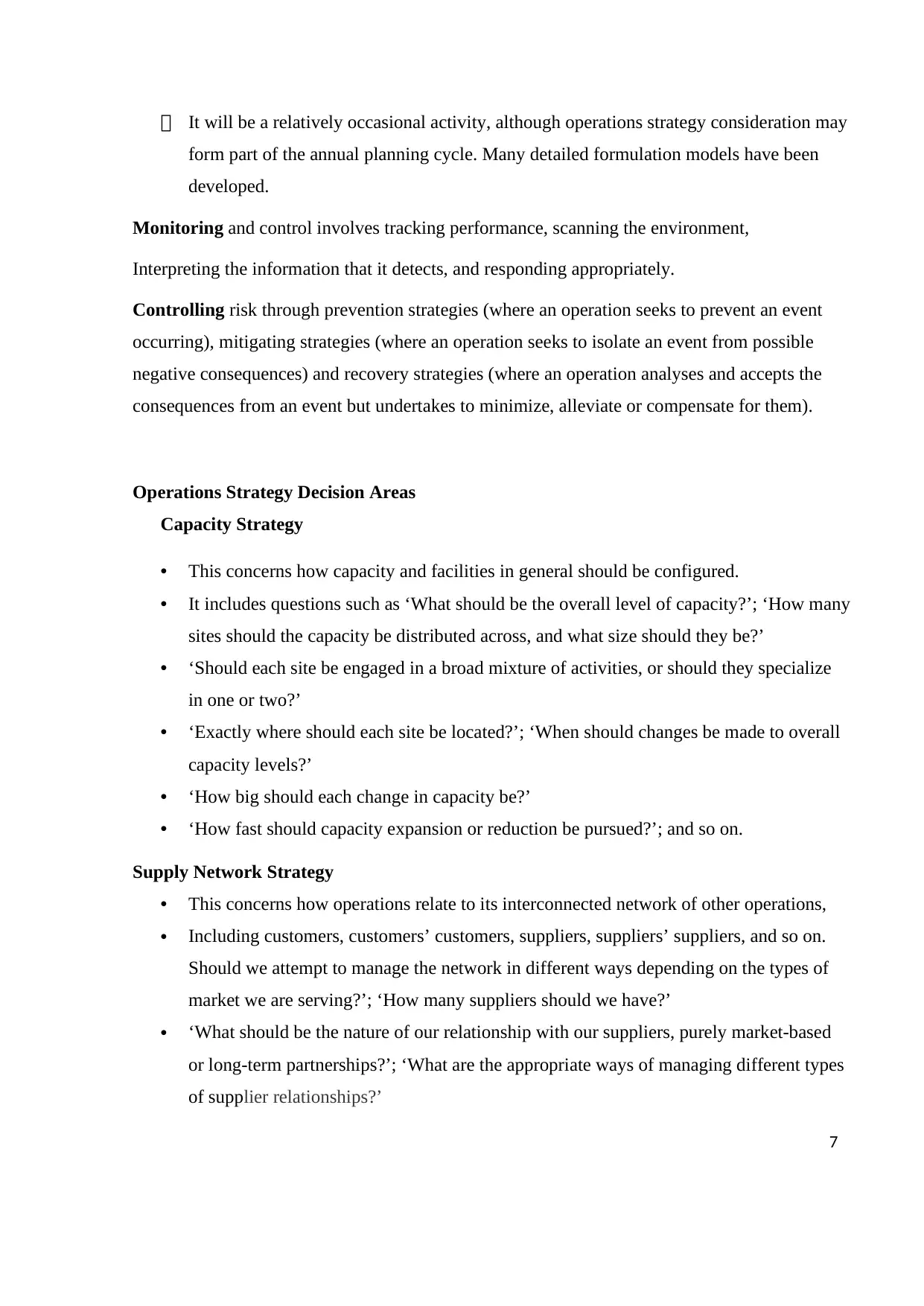
7
It will be a relatively occasional activity, although operations strategy consideration may
form part of the annual planning cycle. Many detailed formulation models have been
developed.
Monitoring and control involves tracking performance, scanning the environment,
Interpreting the information that it detects, and responding appropriately.
Controlling risk through prevention strategies (where an operation seeks to prevent an event
occurring), mitigating strategies (where an operation seeks to isolate an event from possible
negative consequences) and recovery strategies (where an operation analyses and accepts the
consequences from an event but undertakes to minimize, alleviate or compensate for them).
Operations Strategy Decision Areas
Capacity Strategy
• This concerns how capacity and facilities in general should be configured.
• It includes questions such as ‘What should be the overall level of capacity?’; ‘How many
sites should the capacity be distributed across, and what size should they be?’
• ‘Should each site be engaged in a broad mixture of activities, or should they specialize
in one or two?’
• ‘Exactly where should each site be located?’; ‘When should changes be made to overall
capacity levels?’
• ‘How big should each change in capacity be?’
• ‘How fast should capacity expansion or reduction be pursued?’; and so on.
Supply Network Strategy
• This concerns how operations relate to its interconnected network of other operations,
• Including customers, customers’ customers, suppliers, suppliers’ suppliers, and so on.
Should we attempt to manage the network in different ways depending on the types of
market we are serving?’; ‘How many suppliers should we have?’
• ‘What should be the nature of our relationship with our suppliers, purely market-based
or long-term partnerships?’; ‘What are the appropriate ways of managing different types
of supplier relationships?’
It will be a relatively occasional activity, although operations strategy consideration may
form part of the annual planning cycle. Many detailed formulation models have been
developed.
Monitoring and control involves tracking performance, scanning the environment,
Interpreting the information that it detects, and responding appropriately.
Controlling risk through prevention strategies (where an operation seeks to prevent an event
occurring), mitigating strategies (where an operation seeks to isolate an event from possible
negative consequences) and recovery strategies (where an operation analyses and accepts the
consequences from an event but undertakes to minimize, alleviate or compensate for them).
Operations Strategy Decision Areas
Capacity Strategy
• This concerns how capacity and facilities in general should be configured.
• It includes questions such as ‘What should be the overall level of capacity?’; ‘How many
sites should the capacity be distributed across, and what size should they be?’
• ‘Should each site be engaged in a broad mixture of activities, or should they specialize
in one or two?’
• ‘Exactly where should each site be located?’; ‘When should changes be made to overall
capacity levels?’
• ‘How big should each change in capacity be?’
• ‘How fast should capacity expansion or reduction be pursued?’; and so on.
Supply Network Strategy
• This concerns how operations relate to its interconnected network of other operations,
• Including customers, customers’ customers, suppliers, suppliers’ suppliers, and so on.
Should we attempt to manage the network in different ways depending on the types of
market we are serving?’; ‘How many suppliers should we have?’
• ‘What should be the nature of our relationship with our suppliers, purely market-based
or long-term partnerships?’; ‘What are the appropriate ways of managing different types
of supplier relationships?’
Paraphrase This Document
Need a fresh take? Get an instant paraphrase of this document with our AI Paraphraser
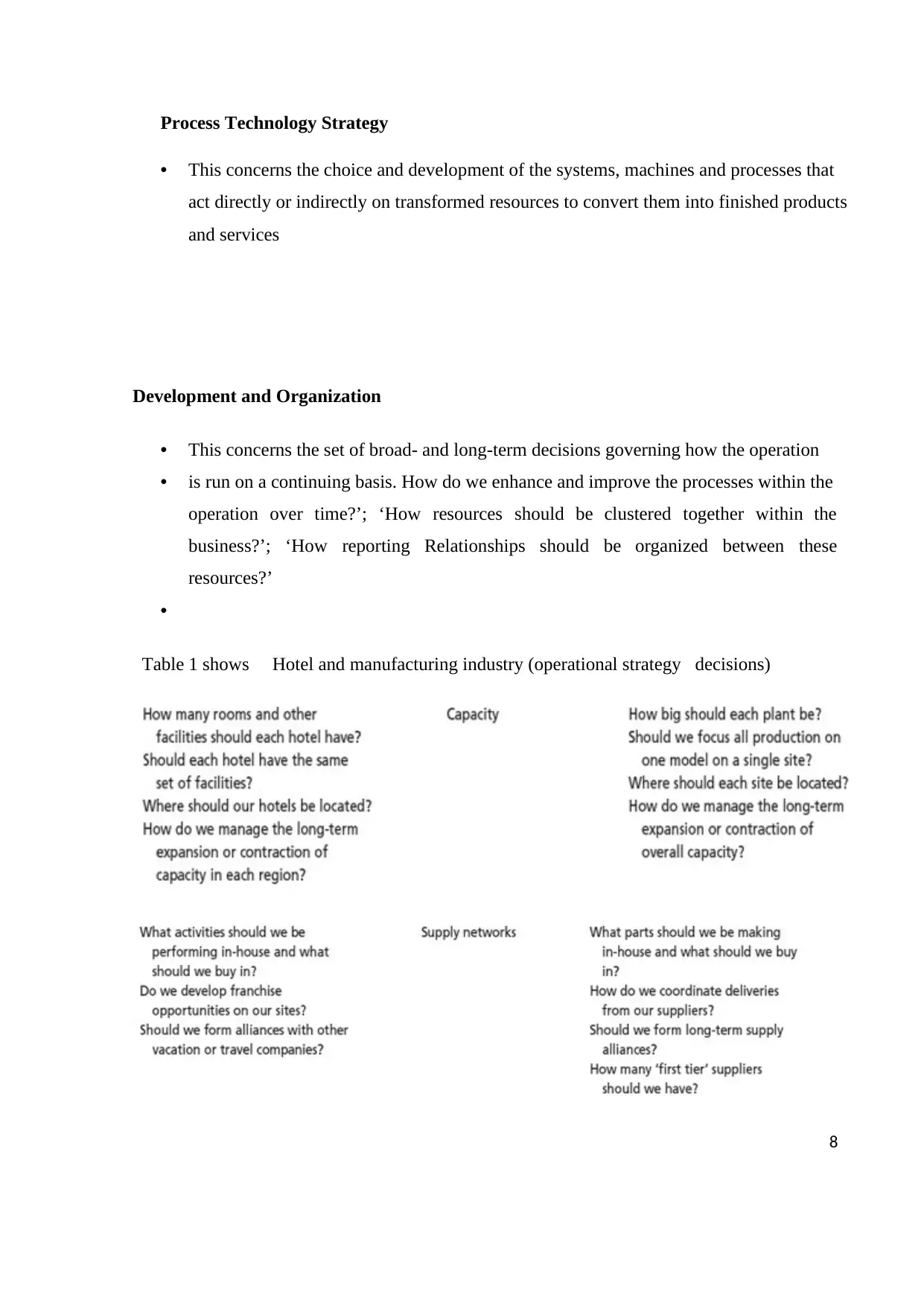
8
Process Technology Strategy
• This concerns the choice and development of the systems, machines and processes that
act directly or indirectly on transformed resources to convert them into finished products
and services
Development and Organization
• This concerns the set of broad- and long-term decisions governing how the operation
• is run on a continuing basis. How do we enhance and improve the processes within the
operation over time?’; ‘How resources should be clustered together within the
business?’; ‘How reporting Relationships should be organized between these
resources?’
•
Table 1 shows Hotel and manufacturing industry (operational strategy decisions)
Process Technology Strategy
• This concerns the choice and development of the systems, machines and processes that
act directly or indirectly on transformed resources to convert them into finished products
and services
Development and Organization
• This concerns the set of broad- and long-term decisions governing how the operation
• is run on a continuing basis. How do we enhance and improve the processes within the
operation over time?’; ‘How resources should be clustered together within the
business?’; ‘How reporting Relationships should be organized between these
resources?’
•
Table 1 shows Hotel and manufacturing industry (operational strategy decisions)
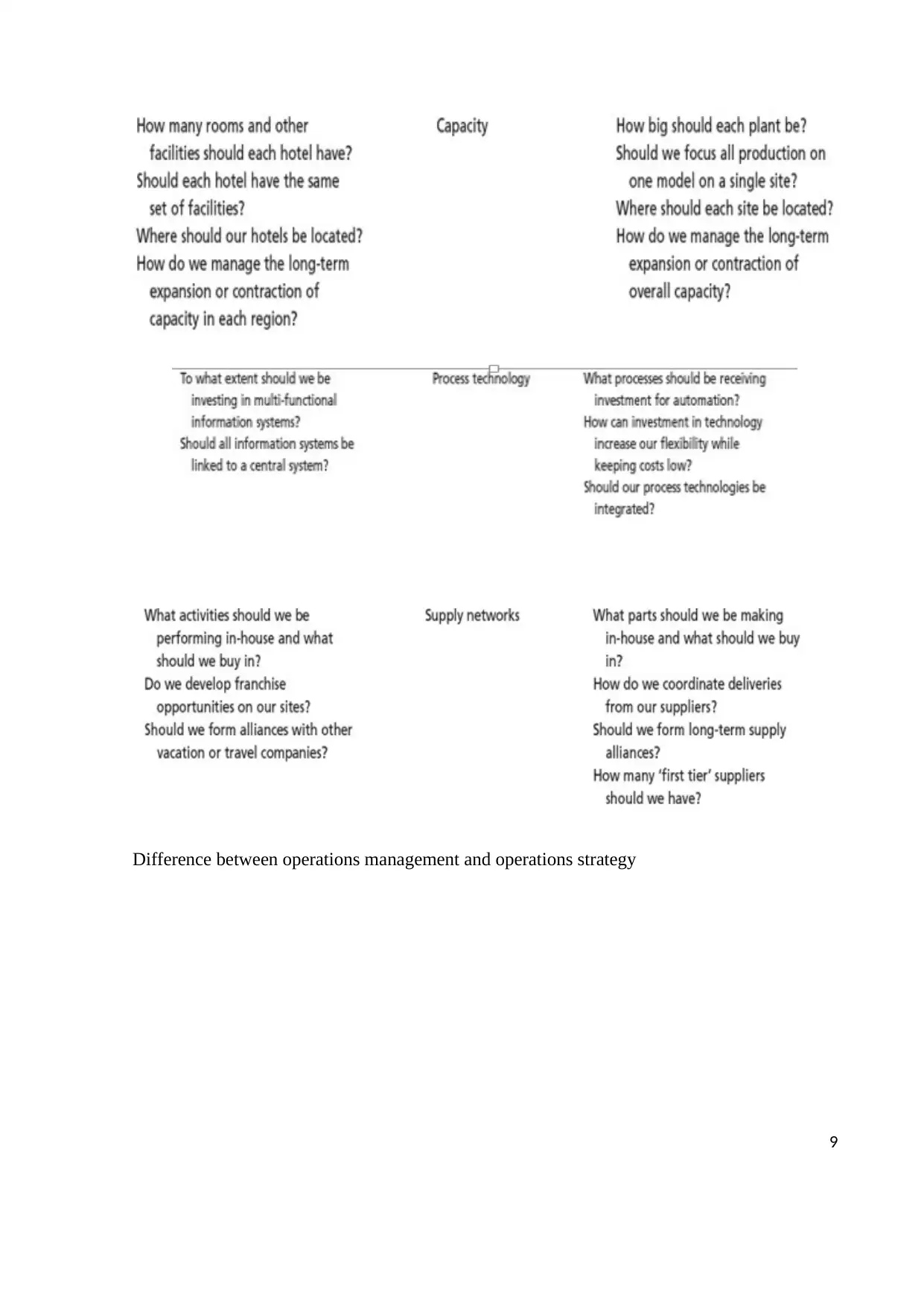
9
Difference between operations management and operations strategy
Difference between operations management and operations strategy
⊘ This is a preview!⊘
Do you want full access?
Subscribe today to unlock all pages.

Trusted by 1+ million students worldwide

10
Fig- 3
Four Perspectives on Operations Strategy
Fig.4
Fig- 3
Four Perspectives on Operations Strategy
Fig.4
Paraphrase This Document
Need a fresh take? Get an instant paraphrase of this document with our AI Paraphraser

11
Operations strategy is a top-down reflection of what the whole group or business wants to
do. An operations strategy (or functional strategy) must reflect the decisions taken at the top
of the organization and which set the overall strategic direction of the organization.
This is called a ‘top-down’ approach to operations strategy. So, if the organization is a large,
diversified corporation, its corporate strategy will consist of decisions about what types of
business the group wants to be in, in what parts of the world it wants to operate, what
businesses to acquire and what to divest, how to allocate its cash between its various
businesses, and so on. Within the corporate group, each business unit will also need to put
together its own business strategy, which sets out its individual mission and objectives, as
well as defining how it intends to compete in its markets.
Operations strategy is a bottom-up activity where operations improvements cumulatively
build strategy.‘ shape the operation’s objectives and action, at least partly by the knowledge it
gains from its day-to-day activities’.
Philosophy of continual and incremental improvement that is built into the strategy-
making process.
Operations strategy involves translating market requirements into operations decisions.
The organization itself usually has some influence over what its markets demand, if for
no other reason than that it has chosen to be in some markets rather than others.
Therefore, by choosing to inhabit a particular market position, the organization is, to
some extent, influencing how easy it is for the operations function to support the market
position.
Operations strategy involves exploiting the capabilities of operations resources in
chosen markets.
How different resources, such as processing centers, are positioned relative to each
other, how staff are organised into units and so on.
These arrangements of resources constitute the processes of the operation that describe
the way things happen in the operation. To return to the automobile analogy, processes
are the mechanisms that power, steer and control its performance.
Operations strategy is a top-down reflection of what the whole group or business wants to
do. An operations strategy (or functional strategy) must reflect the decisions taken at the top
of the organization and which set the overall strategic direction of the organization.
This is called a ‘top-down’ approach to operations strategy. So, if the organization is a large,
diversified corporation, its corporate strategy will consist of decisions about what types of
business the group wants to be in, in what parts of the world it wants to operate, what
businesses to acquire and what to divest, how to allocate its cash between its various
businesses, and so on. Within the corporate group, each business unit will also need to put
together its own business strategy, which sets out its individual mission and objectives, as
well as defining how it intends to compete in its markets.
Operations strategy is a bottom-up activity where operations improvements cumulatively
build strategy.‘ shape the operation’s objectives and action, at least partly by the knowledge it
gains from its day-to-day activities’.
Philosophy of continual and incremental improvement that is built into the strategy-
making process.
Operations strategy involves translating market requirements into operations decisions.
The organization itself usually has some influence over what its markets demand, if for
no other reason than that it has chosen to be in some markets rather than others.
Therefore, by choosing to inhabit a particular market position, the organization is, to
some extent, influencing how easy it is for the operations function to support the market
position.
Operations strategy involves exploiting the capabilities of operations resources in
chosen markets.
How different resources, such as processing centers, are positioned relative to each
other, how staff are organised into units and so on.
These arrangements of resources constitute the processes of the operation that describe
the way things happen in the operation. To return to the automobile analogy, processes
are the mechanisms that power, steer and control its performance.
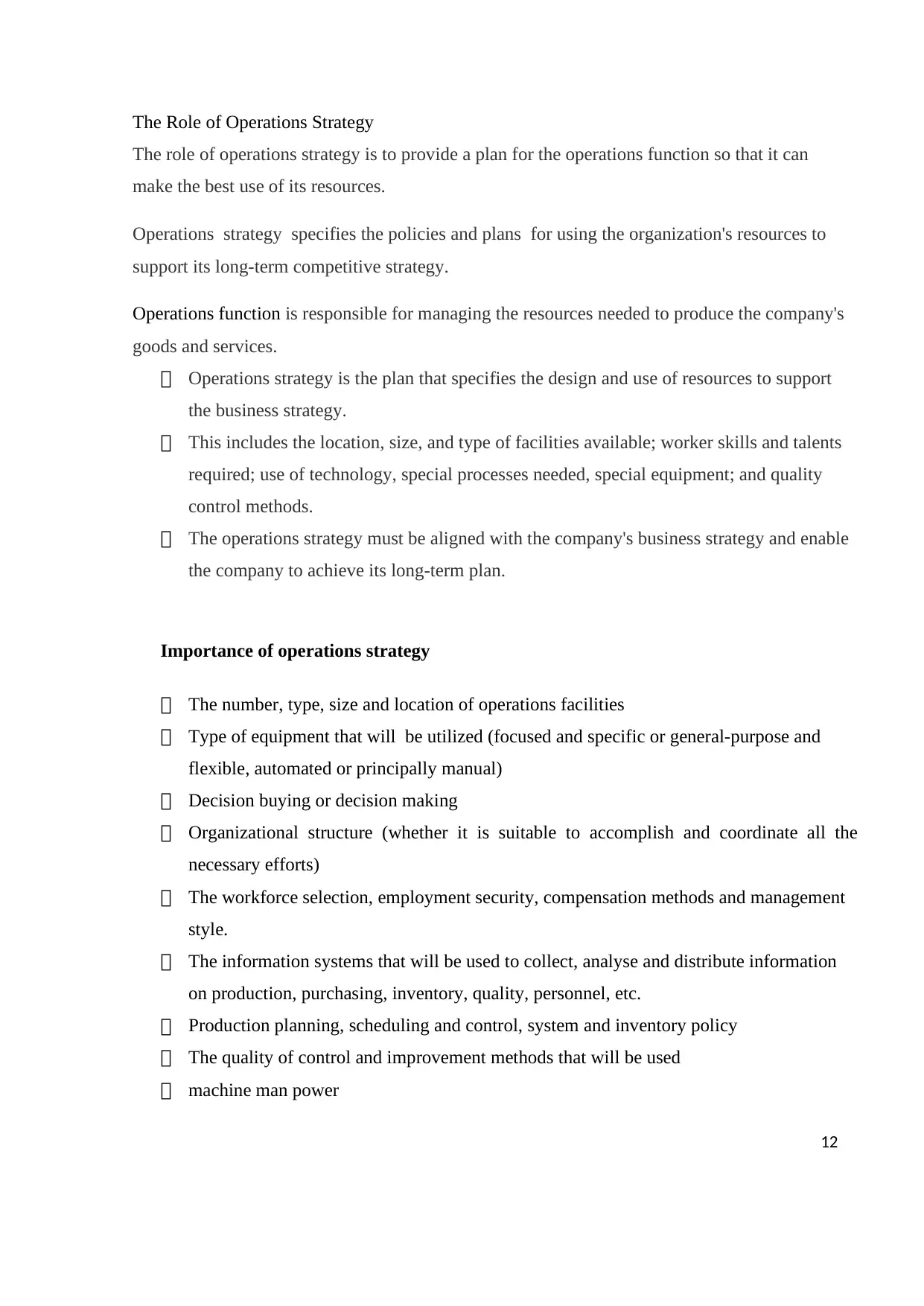
12
The Role of Operations Strategy
The role of operations strategy is to provide a plan for the operations function so that it can
make the best use of its resources.
Operations strategy specifies the policies and plans for using the organization's resources to
support its long-term competitive strategy.
Operations function is responsible for managing the resources needed to produce the company's
goods and services.
Operations strategy is the plan that specifies the design and use of resources to support
the business strategy.
This includes the location, size, and type of facilities available; worker skills and talents
required; use of technology, special processes needed, special equipment; and quality
control methods.
The operations strategy must be aligned with the company's business strategy and enable
the company to achieve its long-term plan.
Importance of operations strategy
The number, type, size and location of operations facilities
Type of equipment that will be utilized (focused and specific or general-purpose and
flexible, automated or principally manual)
Decision buying or decision making
Organizational structure (whether it is suitable to accomplish and coordinate all the
necessary efforts)
The workforce selection, employment security, compensation methods and management
style.
The information systems that will be used to collect, analyse and distribute information
on production, purchasing, inventory, quality, personnel, etc.
Production planning, scheduling and control, system and inventory policy
The quality of control and improvement methods that will be used
machine man power
The Role of Operations Strategy
The role of operations strategy is to provide a plan for the operations function so that it can
make the best use of its resources.
Operations strategy specifies the policies and plans for using the organization's resources to
support its long-term competitive strategy.
Operations function is responsible for managing the resources needed to produce the company's
goods and services.
Operations strategy is the plan that specifies the design and use of resources to support
the business strategy.
This includes the location, size, and type of facilities available; worker skills and talents
required; use of technology, special processes needed, special equipment; and quality
control methods.
The operations strategy must be aligned with the company's business strategy and enable
the company to achieve its long-term plan.
Importance of operations strategy
The number, type, size and location of operations facilities
Type of equipment that will be utilized (focused and specific or general-purpose and
flexible, automated or principally manual)
Decision buying or decision making
Organizational structure (whether it is suitable to accomplish and coordinate all the
necessary efforts)
The workforce selection, employment security, compensation methods and management
style.
The information systems that will be used to collect, analyse and distribute information
on production, purchasing, inventory, quality, personnel, etc.
Production planning, scheduling and control, system and inventory policy
The quality of control and improvement methods that will be used
machine man power
⊘ This is a preview!⊘
Do you want full access?
Subscribe today to unlock all pages.

Trusted by 1+ million students worldwide
1 out of 117
Related Documents
Your All-in-One AI-Powered Toolkit for Academic Success.
+13062052269
info@desklib.com
Available 24*7 on WhatsApp / Email
![[object Object]](/_next/static/media/star-bottom.7253800d.svg)
Unlock your academic potential
Copyright © 2020–2025 A2Z Services. All Rights Reserved. Developed and managed by ZUCOL.





